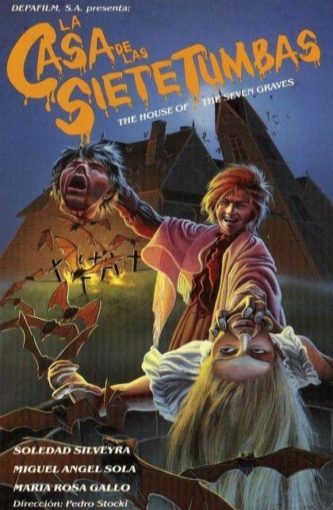 Heavily surreal horror from Argentina that’s confusing and incoherent. In the hands of David Lynch this material may have been interesting, but in its present form the film is merely annoying. HOUSE OF THE SEVEN GRAVES (LA CASA DE LAS SIETE TUMBAS) was directed by the semi-prolific Pedro Stocki. Released in 1982, and screened at Portugal’s popular Fantasporto Film Festival, it quickly fell into complete, and deserved, obscurity.
Heavily surreal horror from Argentina that’s confusing and incoherent. In the hands of David Lynch this material may have been interesting, but in its present form the film is merely annoying. HOUSE OF THE SEVEN GRAVES (LA CASA DE LAS SIETE TUMBAS) was directed by the semi-prolific Pedro Stocki. Released in 1982, and screened at Portugal’s popular Fantasporto Film Festival, it quickly fell into complete, and deserved, obscurity.
A little girl named Cecelia and her friend Clara explore the grounds of a creepy old house, in the backyard of which is an old cemetery containing seven graves—an event that proves quite impactful in the lives of both girls. Years later the two friends, now adults, are still close. Both are single, although Cecelia is having a torrid affair with a good-looking horndog named Armando.
One day Armando and Cecelia are driving down a dirt road and pass by the house of the seven graves. There they happen upon the house’s caretaker, who’s burning stray cats in a mini-bonfire in the front yard, apparently because his boss, the creepy old woman Azucena, can’t stand them. Armando inexplicably asks to stay the night, and Azucena obliges.
Armando is eager to scare Cecelia, and so is delighted at the house’s forbidding architecture and creepy residents. Things turn serious, however, when the window of the bedroom where Armando and Cecelia are sleeping is broken by gunshots.
The following day Cecelia explores the house’s grounds and discovers a madwoman routing around in the mud with several pigs, and also a pointedly placed human skull. Clara, meanwhile, stays at home ripping up old photos. She’s going mad, it seems, and Cecelia’s actions would appear to be the catalyst.
Back at the house of the seven graves, Cecelia is seduced by Azucena. This turns Cecelia against Armando, although that doesn’t stop her from embarking on a boat trip with him, which ends abruptly when they’re attacked by a featureless horse-riding swordsman—who turns out to be Azucena in disguise. Cecelia is urged by the caretaker to kill Azucena, just as Clara decides that it’s Cecelia’s time to die.
As if all that weren’t enough, a couple of drunken hunters enter the grounds of the house, and in the backyard cemetery the dead start rising!
This film might safely be termed incoherent. It’s extremely difficult to follow even in the early scenes, which are relatively straightforward—albeit marred by gratuitous slow motion, weird clanking noises, inappropriate Spanish rock tunes and much confusing intercutting between past, present and the two protagonists. Such things are the norm for the film’s first hour, with the final 30 minutes being positively mind-boggling.
Further confusing matters is the fact that the film, even without taking into account all the surreal elements, is seriously lacking in things like logic and motivation. Why, for instance, does Armando impulsively decide to stay the night at the house of the seven graves? And what of the psychic connection Clara and Cecelia appear to share, and also their overall relationship, which with no explanation goes from friendly to murderous? And what precisely is the significance of the seven graves? No explanations are forthcoming.
The film certainly looks good, with crisp and well composed imagery, and contains some inspired touches, like a slow dissolve from a skull to a close-up of Azucena’s face. There may even be an interesting story contained within the confused morass of horrific flashbacks, psychic warfare, sorcery and madness that comprise this film’s jumbled excuse for a narrative, but I for one had trouble finding it.
Vital Statistics
HOUSE OF THE SEVEN GRAVES (LA CASA DE LAS SIETE TUMBAS)
Depafilm
Director: Pedro Stocki
Producer: Claudio Arbos
Screenplay: Atilio Polverini, Fernando Real
Cinematography: Juan Carlos Lenardi
Editing: Oscar Esparza
Cast: Soledad Silveyra, Miguel Angel Sola, Maria Rosa Gallo, Cecilia Cenci, Walter Soubrie, Enrique Alinso, Martin Coria, Graciela Gramajo, Juan Leyrado, Maria Fernanda Dougan
